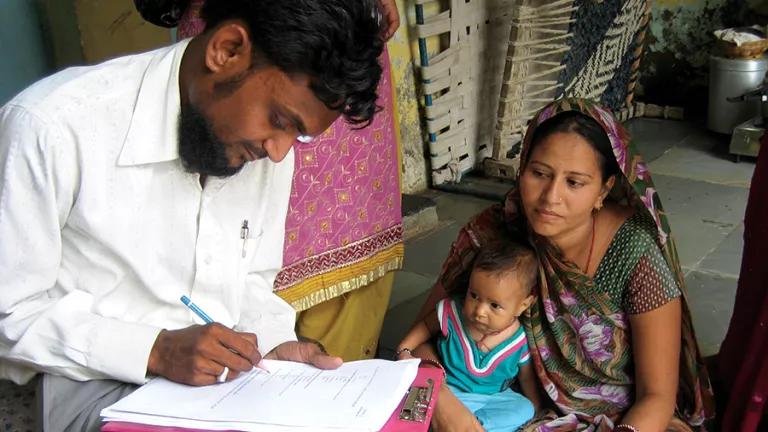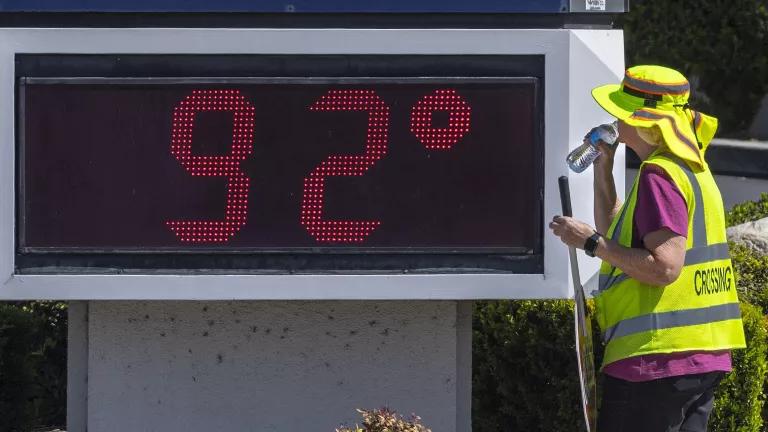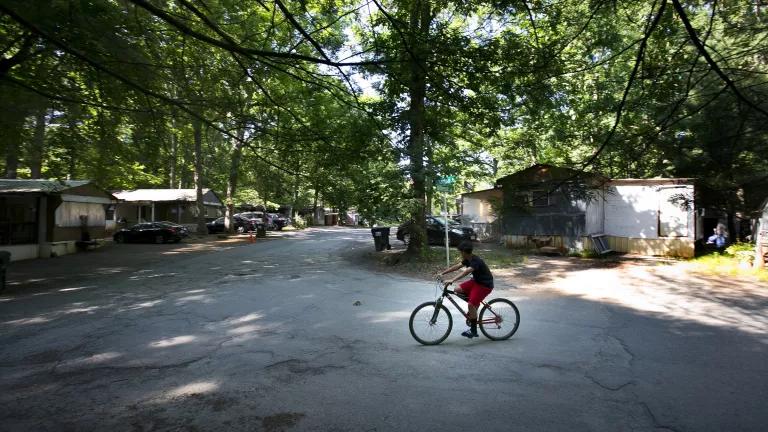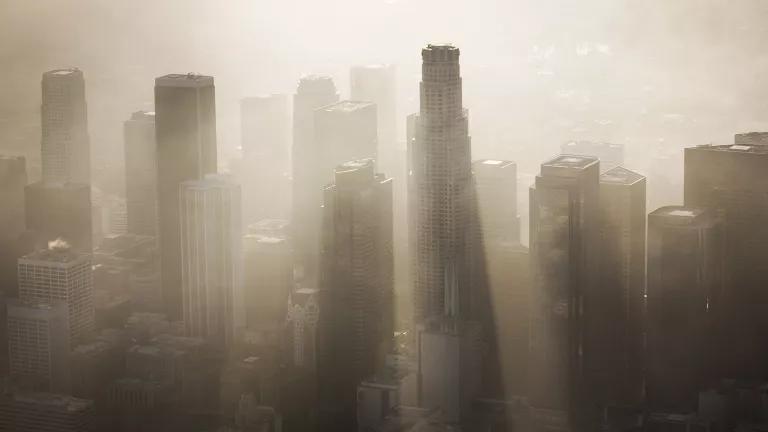Climate Change and Health: Extreme Heat

Across the country, climate change is making heat waves hotter and more frequent.a If that isn't reason enough to sweat, consider the health impacts: As temperatures rise, so do the number of heat-related illnesses, emergency room visits, and deaths. Heat waves have been the top cause of U.S. weather fatalities, on average, over the past 30 years.b
Explore the map by clicking on a state or clicking on the magnifying glass to type in your address. Areas with more than 9 days of extreme heat are living with more days of extreme heat than they did in the past, based on historical records.
Our analysis shows that nearly 210 million Americans—or two-thirds of the population—live in counties vulnerable to health threats from unexpectedly high summer temperatures,c which can cause heat exhaustion and heatstroke or worsen preexisting cardiovascular and respiratory conditions.d An estimated 1,300 excess deaths occurred annually during extreme summer heat from 1975 to 2004,e and more than 65,000 people end up in emergency rooms each summer with heat-related illnesses.f
Older adults, young children, people with chronic illness, lower-income communities, some communities of color, and people who work or exercise outdoors are among the populations most vulnerable to heat-related health effects.g City residents also face a heightened risk because of warmer temperatures in cities from the urban heat island effect, caused by the mostly paved surfaces that absorb and re-radiate heat and the lack of green spaces and tree cover in these areas.h
Through August, 2017 has been the third-hottest year on record in the continental United States, with Florida, Georgia, North Carolina, and South Carolina all registering new highs for the first eight months of a year.i The United States has warmed by about 1.5°F since 1895, with most of the rise occurring since 1970.j If the world continues to increase emissions of carbon pollution, the country could see 5°F to 10°F of additional warming by the end of the century.k
Increases in extreme heat could cause a dramatic rise in illnesses and deaths by the end of the century. For instance, large urban areas such as New York, Philadelphia, Chicago, and Boston could each experience at least six times as many dangerously hot summer days by 2100 as they did, on average, from 1975 to 2010.l Collectively, 45 major urban areas in the United States could see about 28,000 more deaths each year due to extremely hot summer days by the 2090s.m
But we aren’t doomed to this fate. We can keep future climate warming in check and avoid the health threats of climate change by:
- Calling on companies and decisionmakers at all levels of government to help reduce climate-wrecking carbon pollution from power plants, vehicles, and other sources.
- Ensuring our state and local governments are prepared for the health threats of climate change. Today, fewer than one-third of U.S. states have developed a plan to address the health impacts of a warming planet.n
- Taking steps to protect ourselves on dangerously hot days.o
a. U.S. Global Change Research Program, The Impacts of Climate Change on Human Health in the United States: A Scientific Assessment, chapter 2, “Temperature-Related Death and Illness,” 2016, https://health2016.globalchange.gov/temperature-related-death-and-illness.
b. National Weather Service, Natural Hazard Statistics, “Weather Fatalities 2016,” http://www.nws.noaa.gov/om/hazstats.shtml, 2017.
c. For more information on our analysis, please see Frequently Asked Questions. NRDC analysis of data from NOAA, Global Historical Climatology Network (GHCN), https://www.ncdc.noaa.gov/data-access/land-based-station-data/land-based-datasets/global-historical-climatology-network-ghcn (accessed June 15, 2017); and U.S. Census Bureau, “2011–2015 American Community Survey 5-Year Estimates,” 2015, https://factfinder.census.gov (accessed June 15, 2017).
d. U.S. Global Change Research Program, The Impacts of Climate Change on Human Health.
e. Kalkstein, L.S., et al., “An Evaluation of the Progress in Reducing Heat-Related Human Mortality in Major U.S. Cities,” Natural Hazards 56, no. 1 (2010): 113-129, https://link.springer.com/article/10.1007%2Fs11069-010-9552-3 (accessed July 21, 2017).
f. Hess, J. J., et al., “Summertime Acute Heat Illness in U.S. Emergency Departments from 2006 Through 2010: Analysis of a Nationally Representative Sample,” Environmental Health Perspectives 122, no. 11 (2014): 1209-1215, https://ehp.niehs.nih.gov/1306796/, (accessed July 21, 2017).
g. U.S. Global Change Research Program, The Impacts of Climate Change on Human Health.
h. U.S. Environmental Protection Agency, “Reducing Urban Heat Islands: Compendium of Strategies—Draft,” 2008, www.epa.gov/heat-islands/heat-island-compendium, (accessed July 21, 2017).
i. NOAA, National Centers for Environmental Information, “Assessing the U.S. Climate in August 2017,” 2017, https://www.ncei.noaa.gov/news/national-climate-201708, (accessed September 8, 2017).
j. U.S. Global Change Research Program, Climate Change Impacts in the United States: The Third National Climate Assessment, chapter 2, “Recent U.S. Temperature Trends,” 2014, http://nca2014.globalchange.gov/report/our-changing-climate/recent-us-temperature-trends (accessed July 21, 2017).
k. Ibid.
l. Natural Resources Defense Council, “Killer Summer Heat: Paris Agreement Compliance Could Avert Hundreds of Thousands of Needless Deaths in America’s Cities,” 2017, https://www.nrdc.org/sites/default/files/killer-summer-heat-paris-agreement-compliance-ib.pdf (accessed June 29, 2017).
m. Ibid.
n. 1. Georgetown Climate Center, “State and Local Adaptation Plans,” 2017, http://www.georgetownclimate.org/adaptation/index.html (accessed June 29, 2017).
o. For more information on how we can protect ourselves from extreme heat, see Frequently Asked Questions.
Climate Change and Health: Extreme Heat FAQs
The interactive map explores how climate change threatens our health in the most direct way possible—through global warming and the increased frequency of extremely hot summer days. Analyzing data from temperature sensors all across the country, we found that nearly 210 million Americans—or two-thirds of the population—are threatened by exposure to more frequent days of extreme heat than they were just a few decades ago, during the period from 1961 to 19901.
EXTREME HEAT — STATE BY STATE
DOWNLOAD THE CHART (PDF)
By entering your address or clicking on a state, you can explore how climate change is affecting temperatures and threatening public health in your area. We also explain what—if anything—state governments are doing, in the absence of leadership at the national level, to address the health impacts of hotter and longer heat waves and to reduce emissions of heat-trapping carbon pollution that causes climate change and fuels heat waves.
Climate change is one of the most serious health threats we face, with the World Health Organization warning that about 250,000 additional deaths globally will be caused by climate change each year between 2030 and 2050.2 As climate-changing pollution from fossil fuels drives up global temperatures, the threat of a wide range of serious health risks also increases—from asthma and heat-related illnesses to infectious diseases like Lyme and Zika.
Extreme heat is a significant public health threat in the United States. Exposure can cause heat exhaustion and heatstroke and can worsen preexisting cardiovascular and respiratory conditions.3 An estimated 1,300 excess deaths occurred annually, on average, during extreme summer heat from 1975 to 2004.4 And more than 65,000 people, on average, end up in emergency rooms each summer with heat-related illnesses.5
Global warming occurs when carbon dioxide (CO2) and other heat-trapping air pollutants (greenhouse gases) from power plants, vehicles, and other sources collect in the atmosphere and trap heat radiating from the earth’s surface. These air pollutants—which can last for years to centuries in the atmosphere—absorb the heat and cause the planet to get hotter. This is known as the greenhouse effect.
The map shows the number of days with extreme summer heat in counties across the country for the 10-year period from 2007 to 2016, rounded to the nearest whole number of days per summer. For each county, we calculated the average number of extreme summer heat days per year, broken into four categories:
- Nine or fewer extreme heat days per year (≤9 days, yellow)
- More than 9 to 14 extreme heat days per year (>9 to 14 days, orange)
- More than 14 extreme heat days per year (>14 days, red)
- Insufficient data to perform the calculation (gray)
We used information from the Global Historical Climatology Network (GHCN), which includes National Weather Service (NWS) data as well as data from all cooperative weather stations—U.S. stations operated by local observers who generally report daily maximum and minimum temperatures and precipitation.6
“Extreme heat days” are defined as those summer days, from June 1 to August 31 in the years 2007 to 2016, on which the daily maximum temperature exceeded the 90th percentile value calculated from June to August daily maximum temperatures from a 1961-to-1990 reference period for the same monitoring station. As in NRDC’s 2011 extreme heat mapping analysis, the 90th percentile value was chosen from a range of definitions of extreme heat that could be applied.7
The total number of days that exceeded the 90th percentile reference value was computed for each monitoring station. County-level averages were then computed by averaging station-level data from sites within the county and from each of the 10 years.
There are a total of 92 days during the period we define as summer (June 1 through August 31), so the “expected” number of extreme heat days that would exceed the 90th percentile value is 9.2 days. Rounding to the nearest whole number, locations averaging more than nine days per summer with daily maximum temperatures above that station’s 90th percentile reference value had a “more than expected” number of days of extreme heat. The highest category (more than 14 days) gives a sense of those locations with more than two weeks of these extreme heat days in the past decade (2007 to 2016), compared with the period from 1961 to 1990 at that location.
It’s important to note that an “extreme heat day” is defined by local temperatures at each site. The map does not compare temperatures in one part of the United States with those in another region.
Estimates of populations potentially affected by extreme heat were taken from the 2015 U.S. Census.8 The numbers of reported heat-related deaths between 2005 and 2013 are from the Centers for Disease Control and Prevention’s (CDC) National Environmental Public Health Tracking Network.9
The gray areas represent counties that have insufficient data; they do not indicate anything about temperatures. These counties either lack a temperature monitoring station or fail to meet the data completeness requirements of this analysis. Monitoring sites were excluded from the analysis if: (a) they had data for less than 75 percent of the possible reference days from 1961–1990; (b) one entire year from the 2007–2016 study period was missing; or (c) they had data for less than 75 percent of the possible study period days from 2007–2016.
State data were taken from the CDC’s National Environmental Public Health Tracking Network, which tallies deaths with heat specifically listed as a direct or indirect cause—including deaths from heatstroke.10 This method significantly underestimates the true number of heat-related deaths, however. For example, a deadly heart attack during a heat wave may not be counted as a “heat-related death,” even if exposure to extreme heat triggered the heart attack.11
NRDC’s heat analysis in 2011 covered data from the period 2000 to 2009, which overlaps somewhat with the new map’s study period of 2007 to 2016. Thus, the two analyses can’t be directly compared.
However, our new data give some indications of a warming trend, relative to the results of NRDC’s previous analysis. There is now a greater number of people living in areas with more than 14 days of extreme heat: 103 million people (one-third of the U.S. population) in 2017, versus 59 million (one-fifth of the population) previously. Furthermore, there are appreciably fewer people living in areas with nine or fewer days of extreme heat: 44 million people (14 percent of the population) in this analysis, versus nearly 54 million (18 percent of the population) previously.12,13
The reasons for these shifts in numbers of people affected include the increasing extent and frequency of extreme heat days, increases in the overall U.S. population, and continued movement of people to cities, where extreme heat can be exacerbated by urban sprawl and the urban heat island effect.14
Governments at all levels—federal, state, and local—must prepare for the health threats of climate change. Fewer than one-third of states have developed a plan to address the health impacts of our changing climate.15
Investing in preparedness for extreme heat events can help limit the health harms already being faced by communities, which will worsen under a changing climate. Adaptation strategies that can protect health include establishing early warning systems with advance forecasts of extreme heat events, opening cooling centers that offer access to air-conditioning, and helping hospitals and health care systems to be ready as response centers when heat waves strike.16 Local governments can also take actions to build the resilience of their communities in coping with extreme heat, such as planting trees, switching to cooler paving materials, and installing vegetated “green” roofs to help reduce the heat island effect in cities.17
To limit global warming and build a better future for our children, we must also fight climate change by addressing the root cause: heat-trapping pollution from fossil fuels. At the global level, countries—including the United States—should follow through on their international commitments to shift away from fossil fuels toward cleaner, smarter energy options.
Here at home, America needs to fully implement existing climate policies like the Clean Power Plan, which established the first national limits on carbon pollution from power plants, and greenhouse gas limits for cars and trucks. To fully protect our health, companies and decision makers at all levels of government should also go beyond existing policies to make deep cuts in the pollution warming our climate.
Prevention is the best defense. People should avoid spending too much time in direct sunlight and use shaded outdoor areas instead. Make use of local cooling centers or air-conditioned spaces to cool off periodically. If spending time outdoors, the EPA recommends wearing sunscreen of SPF 15 or higher. Drink water, check in on homebound friends and neighbors, and listen for local weather and heat alert information. Extra care should be taken with vulnerable people, such as children, the elderly, and the sick. No person or animal should ever be left alone in a car.18
1. NRDC analysis of data from the National Oceanic and Atmospheric Administration (NOAA), Global Historical Climatology Network, https://www.ncdc.noaa.gov/data-access/land-based-station-data/land-based-datasets/global-historical-climatology-network-ghcn (accessed June 15, 2017); and U.S. Census Bureau, “2011–2015 American Community Survey 5-Year Estimates,” 2015, https://factfinder.census.gov (accessed June 15, 2017).
2. World Health Organization, “Climate Change and Health,” 2016, http://www.who.int/mediacentre/factsheets/fs266/en/ (accessed May 1, 2017).
3. U.S. Global Change Research Program, “Temperature-Related Death and Illness,” chapter 2 in The Impacts of Climate Change on Human Health in the United States: A Scientific Assessment, 2016, https://health2016.globalchange.gov/temperature-related-death-and-illness (accessed July 21, 2017).
4. Kalkstein, Laurence S., et al., “An Evaluation of the Progress in Reducing Heat-Related Human Mortality in Major U.S. Cities,” Natural Hazards 56, no. 1 (January 2011):113-129, https://link.springer.com/article/10.1007%2Fs11069-010-9552-3 (accessed July 21, 2017).
5. Hess, Jeremy J., Shubhayu Saha, and George Luber, “Summertime Acute Heat Illness in U.S. Emergency Departments from 2006 Through 2010: Analysis of a Nationally Representative Sample,” Environmental Health Perspectives 122, no. 11 (November 2014), https://ehp.niehs.nih.gov/1306796/ (accessed July 21, 2017).
6. NOAA, Global Historical Climatology Network.
7. World Meteorological Organization/World Health Organization, Heatwaves and Health: Guidance on Warning-System Development (WMO-No. 1142), 2015, http://www.who.int/globalchange/publications/WMO_WHO_Heat_Health_Guidance_2015.pdf (accessed September 1, 2017).
8. U.S. Census Bureau, “2011–2015 American Community Survey” (accessed June 5, 2017).
9. Centers for Disease Control and Prevention, National Environmental Public Health Tracking Network, “Better Information for Better Health,” 2017, https://ephtracking.cdc.gov/showHome.action (accessed June 15, 2017).
10. Centers for Disease Control and Prevention, National Environmental Public Health Tracking Network, “Indicators and Data,” 2017, https://ephtracking.cdc.gov/showIndicatorPages (accessed June 15, 2017).
11. Centers for Disease Control and Prevention, “Picture of America Report: Heat-Related Illness,” 2017, https://www.cdc.gov/pictureofamerica/pdfs/Picture_of_America_Heat-Related_Illness.pdf (accessed August 15, 2017).
12. U.S. Census Bureau, “2010 Census Summary File 1,” 2010, https://factfinder.census.gov, (accessed June 15, 2017).
13. NRDC analysis of data from NOAA, Global Historical Climatology Network; and U.S. Census Bureau, “2011-2015 American Community Survey.”
14. Stone, Brian, Jeremy J. Hess, and Howard Frumkin, “Urban Form and Extreme Heat Events: Are Sprawling Cities More Vulnerable to Climate Change Than Compact Cities?” Environ Health Perspect 118, no. 10 (October 2010):1425-1428, https://www.ncbi.nlm.nih.gov/pmc/articles/PMC2957923/ (accessed August 24, 2017).
15. Georgetown Climate Center, “State and Local Adaptation Plans,” 2017, http://www.georgetownclimate.org/adaptation/index.html (accessed June 29, 2017).
16. U.S. Global Change Research Program, “Climate Change Impacts in the United States: The Third National Climate Assessment,” chapter 9, http://nca2014.globalchange.gov/report/sectors/human-health, 2014 (accessed July 21, 2017).
17. U.S. Environmental Protection Agency, “Extreme Heat,” 2017, https://www.epa.gov/natural-disasters/extreme-heat#prepare (accessed August 15, 2017).
18. U.S. Environmental Protection Agency, “Extreme Heat.”
Find out how we did the map and analysis
Map
The map shows the average number of extreme summer heat days a year, from 2007 to 2016, rounded to the nearest whole integer. The categories mapped are: more than 14 extreme heat days per year (red); greater than 9 to 14 extreme heat days per year (orange); 9 or fewer extreme heat days per year (yellow); and insufficient data to perform the calculation (gray).
“Extreme heat days” are defined as those days from June 1 to August 31 in the years 2007 to 2016 on which the maximum temperature exceeded the 90th-percentile value. We used the June to August daily maximum temperatures from the 1961 to 1990 reference period for the same monitoring station to calculate the 90th percentile. The 90th percentile value is among the more common ways to define extreme heat and was likewise used in NRDC’s 2011 heat-mapping analysis.1
There are a total of 92 days from June 1 to August 31, so the expected number of days that would exceed the 90th percentile value is 9.2 days. (Or, rounding to the nearest whole number, 9 days.) Therefore, for the 2007 to 2016 study period, locations with more than 9 days per summer, on average, with temperatures above that location’s 90th-percentile reference value were considered to have “more than expected” numbers of days of extreme heat. The highest category shown on the map (more than 14 days) gives a sense of those locations that now experience more than two weeks’ worth of extreme heat days per year.
Note that “extreme heat” is defined by local temperatures at each site; the map does not compare temperatures in one part of the country to those in another region.
Data sources
Historical temperature data for all cooperative weather stations for all years were downloaded from the Global Historical Climatology Network (GHCN), formerly the National Climatic Data Center.2 Geographic detail for stations was also downloaded from GHCN, which defines cooperative stations as “U.S. stations operated by local observers which generally report max/min temperatures and precipitation. National Weather Service (NWS) data are also included in this dataset. The data receive extensive automated + manual quality control.”
Calculations
For each station, we calculated the 90th percentile for the maximum daily temperature during the reference period of June, July, and August of 1961 to 1990. We then computed the total number of days on which the maximum daily summer temperature exceeded the 90th-percentile reference for that station for each year in the most recent decade, from 2007 to 2016. County-level averages of the number of extreme heat days were then calculated by averaging station-level data from stations within the county and from each of the 10 years.
Stations were excluded from the analysis if: (a) they had data for less than 75 percent of possible reference days available; (b) one entire year from the 2007 to 2016 study period was missing; or (c) they had data for less than 75 percent of possible study period days available.
Population
Estimates of population living in counties with more than nine extreme heat days per year (i.e.,"more than expected") were taken from the 2015 U.S. Census.3
Health data
Heat-related health data largely are from the Centers for Disease Control and Prevention’s (CDC) National Environmental Public Health Tracking Network,4 which tallies deaths with heat specifically listed as a direct or indirect cause, including deaths from heatstroke.5 This method significantly underestimates the true number of heat-related deaths, however. For example, a deadly heart attack during a heat wave may not be counted as a “heat-related death,” even if exposure to extreme heat triggered the heart attack.6 In addition, since the CDC does not report data in years when the total number of heat-related deaths is determined to be too low, it may be underestimating the health impact.
Citations
1. World Meteorological Organization/World Health Organization, Heatwaves and Health: Guidance on Warning-System Development (WMO-No. 1142), http://www.who.int/globalchange/publications/WMO_WHO_Heat_Health_Guidance_2015.pdf?ua=1 (accessed August 22, 2017).
2. NOAA, Global Historical Climatology Network (GHCN), https://www.ncdc.noaa.gov/data-access/land-based-station-data/land-based-datasets/global-historical-climatology-network-ghcn (accessed June 15, 2017).
3. U.S. Census Bureau, “2011–2015 American Community Survey 5-Year Estimates,” 2015, https://factfinder.census.gov (accessed June 5, 2017).
4. Centers for Disease Control and Prevention, National Environmental Public Health Tracking Network, 2017, https://ephtracking.cdc.gov/showHome.action (accessed June 15, 2017).
5. Centers for Disease Control and Prevention, National Environmental Public Health Tracking Network, “Indicators and Data,” 2017, https://ephtracking.cdc.gov/showIndicatorPages (accessed June 15, 2017).
6. Centers for Disease Control and Prevention, “Picture of America Report: Heat-Related Illness,” 2017, https://www.cdc.gov/pictureofamerica/pdfs/Picture_of_America_Heat-Related_Illness.pdf (accessed August 15, 2017).
Credits
Project teams: NRDC Science Center, Communications Department, Climate & Clean Air program
Researchers and writers (alphabetical order): Tom Barkley, Juanita Constible, Kim Knowlton, Will Shafer
Reviewers (alphabetical order): Sean Alcorn, Hunter Jones, Linda Rudolph, Sayantan Sarkar, Christina Swanson
Editor: Sarah Engler
Data analysis and map production (alphabetical order): Alex Hart, Kate McKenney, ZevRoss Spatial Analysis
Related Content

Rising Temperatures, Deadly Threat: Preparing Communities in India for Extreme Heat Events

Occupational Heat Safety Standards in the United States

Feeling the Heat: How California’s Workplace Heat Standards Can Inform Stronger Protections Nationwide

Heat Stress Is Killing Workers. States Can Protect Them.

Fighting Climate Change and Heatstroke One Home at a Time

